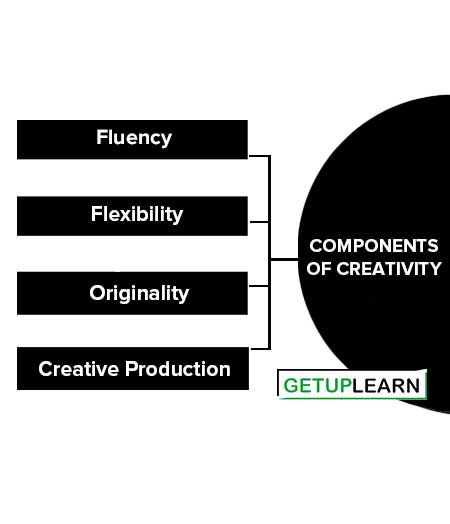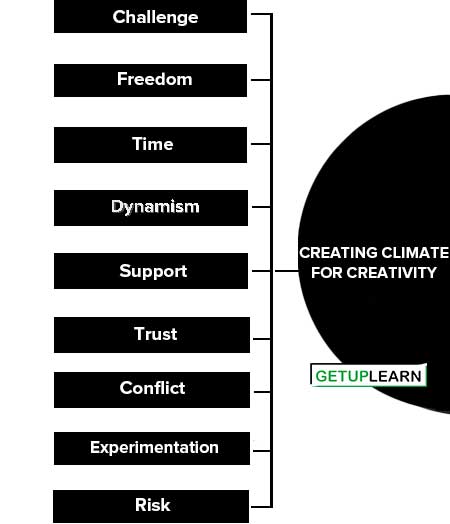Table of Contents
What is Creativity?
Creativity is defined as the tendency to generate or recognize ideas, alternatives, or possibilities that may be useful in solving problems, communicating with others, and entertaining ourselves and others.
Definition of Creativity
Creativity is the ability to see new relation to reduce unusual ideas and to deviate from traditional patterns of thinking . Some psychologists think, that, in presence of creativity person can present a new series or arrangement in the environment.
Eysenck (1972)
Creativity is a cognitive empirical process from which an original roduct emerges or it is a bility of multidimensional human attributes differently distributed among people.
Getuplearn
It is spontaneous and inner-directed. it includes the factors like ability to see and view relationships produce unusual ideas, solve problems, fluency, flexibility originality, acquisitiveness, and persistency.
Elements of Creativity
Some important characteristics or elements of creativity:
- Fluency
- Flexibility
- Originality
- Problem Sensitivity
- Unraveling Causes and Effects
- Elaborateness
- Problem Restructuring
- Expertise
- Creative Thinking Skill
- Motivation
Fluency
It measures a person’s ability to come up with a number of solutions to a given problem. Those who come up with a large number of uses would be called ideationally fluent people. An ideationally fluent person tends to come up with a greater variety of solutions as well as a larger number of unusual solutions than a person who is ideationally not fluent.
Flexibility
It is the ability to provide a large variety of solutions to respond to a problem from a variety of viewpoints. Another ability that is also required is the ability to use a variety of approaches in problem solving.
Originality
It is the ability to come up with unusual but appropriateness. A related ability is the ability to come up with a relationship between ideas or two frames or references.
Problem Sensitivity
It is the ability to notice the unexplained, the unsatisfactory, or the incongruent, or the ability to sense the problems.
Unraveling Causes and Effects
It is the ability to go to the roots of a phenomenon by unraveling its causes and equally visualize its consequences. It is a vital ingredient to scientific creativity as well as artistic creativity.
Elaborateness
It is the ability to elaborate on a theme. Actually, it is the difference between the idea that man has considerable creative potential and a full-fledged training program for increasing creativity. The ability to elaborate is indispensable in putting a creative idea to work.
Problem Restructuring
It is the ability to go behind the surface features of a problem and see what the real problem. Constitutions of creative abilities are not available in equal measures in the same individual.
The individual who can deal fluently may not be very original and vice versa. It is, therefore, inappropriate to categorize a person as creative or uncreative without specifying the dimensions on which he has high ability and the ones on which he has more limited ability.
Expertise
Expertise encompasses everything that a person knows and can do in the broad domain of his or her work knowledge and technical ability.
Creative Thinking Skill
Creative thinking refers to how you approach problems and solutions – the capacity to put existing ideas together in new combinations. The skill itself depends quite a bit on personality as well as on how a person thinks and works. Expertise and creative thinking are the entrepreneur’s raw materials or natural resources.
Motivation
Motivation is the drive and desire to do something, an inner passion and interest. When people are intrinsically motivated, they engage in their work for the challenges and enjoyment of it. The work itself is motivating.
People will be most creative when they feel motivated primarily by the interest, satisfaction, and challenges of the work itself “the labor of love”, love of the work “the enjoyment of seeing and searching for an outstanding solution a breakthrough.
Components of Creativity
Below that we have explained the components of creativity:

Fluency
It refers to the rapid flow of ideas and tendencies to change the direction of the units of products.
Flexibility
It is the readiness to change behavior to meet changing circumstances. It represents a number of classes of objects. It indicates how many distinct different ways an individual can respond to a stimulus.
Originality
It refers to the unusual ideas and suggestions for unusual applications of particular objects. It indicates uncommonness or newness in the product.
Creative Production
it refers to possessing both literary and constructive creativities. The semantic contents through divergent thinking give Units and figural contents resulting in transformations.
Creating Climate for Creativity
Creativity does not happen in an intellectual Vacuum nor in emotional icebergs that many organizations fashion for themselves.
Research around creative culture and general climate has led to the identification of key areas on which organizations can focus to develop effective climates in which people are not only creative but where they are motivated to develop these ideas into value-adding contributions to the success of the whole organization.
Goran Ekval identified the following dimensions that affect organizational creativity:

Challenge
People working in organizations, who feel challenged emotionally engage in their work. It becomes a part of them, not just something they do. They feel the need to get out there and act, not just sit back and dream.
Organizations can challenge people by linking a deep understanding of individual talents, potential, and motivation with the strategic intent.
Freedom
People are empowered to act in ways that are not tightly constrained by narrow job descriptions and management oversight. They have the personal freedom of choice and resources that give them true authority to achieve the challenge they have been given.
Time
When people have a certain amount of unallocated time in their timetable, then if they feel challenged and feel the freedom to act, then they will use that time productively to develop new ideas, as discovering and developing ideas take time.
Dynamism
The eventfulness of life in the organization is needed that drive forward, toward success.
Support
In fact the more Valuable the ideas, the more support it is likely to need, as it may lead to entire changes in direction for the whole organization because of situations in which the gravitas, the authority, the wider capability of more senior managers.
Trust
In the development of ideas, trust is needed on both sides of the house. The person with the idea must feel they can speak their mind without fear of criticism or punishment.
The persons on the other side also need to trust that the person with the idea has the organization’s best interest at heart and will not abandon their other work in the sole pursuit of a very shaky idea.
Conflict
Crating healthy conflicts requires both an openness to challenge and then a focus on the problem, not the people. Respect for the individual is a fundamental element of creative culture. In organizations in which conflict is allowed, it enables felt challenges to be voiced and for people to argue their cases.
In a creatively supporting climate, the conflict is mostly about the problems of the organization and the viability of ideas, and it is most certainly not about personalities and the value of different characters.
Experimentation
It is one thing to think up an idea, it is another to put it into practice. Ideas that are not explored and experimented with will either never see the light of day or may will fail on their first outing.
An experimenting culture has a strong bias for action in trying things out. It does not expect things to work the first time but it does expect to learn through careful trials and subsequent analysis.
Risk
Offering ideas and trying out experiments requires the ability and motivation to take risks. Individuals and the entire organization need to be able to stick their needs out and ‘give it a go’.
Thus creativity is not something that can be turned on at will, but rather by the result of long-term exposure to an encouraging climate.
Creative Organization
Creative organization is made of two words creativity + organization while creativity is the tendency to generate or recognize ideas, alternatives, or possibilities that may be useful in solving problems, communicating with others, and entertaining ourselves and others.
And the organization is the process that deals with the grouping of activities and establishing authority relationships among various people working within the organization. Thus creative organizations can be defined as organizations that are designed to administer, maintain and protect what already exists with creative thinking as designed to bring into existence that which has never been before.
Characteristics of creative organization:
- Balance planning with improvising.
- Use the unknown as a resource.
- Creativity is a core value.
- Creativity is an organizational discipline; an ongoing process; a mindset.
- Time and attention are dedicated to practicing the creative process until it becomes embedded in the system.
- Flexible, limited organizational system combined with intensive interaction.
- Room for exploration and discovery without judgment.
- Act upon intuition and ‘Response as well as logic.
- Employ real-time feedback loops and adapt accordingly.
- Mistakes and failures are seen as invitations to improve, grow or create.
- Hold organizational tension, cognitive dissonance, and natural resistance.
- Engage paradox – engages opposing or differing ‘Truths’ and viewpoints without needing to boil them down to the lowest common denominator.
- Using diversity productivity – uses differences to contribute to the creation of something new.
- Creativity may come from anywhere in the system in any direction. * Using both linear and nonlinear ways of thinking.
- Believe in their people: draws forth what is positive.
- Encourage the questioning of all assumptions.
- Informed by, but not limited to what worked in the past.
- Not reliant on business buzzwords uses more authentic language.
- Excitement is not squelched – it is used to fuel creativity.
Tolerate ambiguity and Uncertainty.
- Using both divergent and convergent thinking: Whole brain approaches.
- Balance structure and ‘being organized’ with flow and emergence.
- Value fun as part of the creative process.
On going through the various characteristics of the creative organization, we summarize that the creative organization requires two dimensions to be successful.
Firstly: it needs to be able to attract and get the best out of creative people. Secondly: it needs a process to harness that creativity and translate it into products and services that customers want.
The first dimension requires the organization to not just recruit and manage creative people but also to realize the creativity of its existing workforce. In the latter, the organization is treading a delicate path between fostering a climate of creativity and the reality of business survival.
FAQs Section
What is the definition of creativity?
Creativity is the ability to see new relations to reduce unusual ideas and to deviate from traditional patterns of thinking. Some psychologists think, that, in the presence of creativity a person can present a new series or arrangement in the environment.
What is the meaning of creativity?
Creativity is defined as the tendency to generate or recognize ideas, alternatives, or possibilities that may be useful in solving problems, communicating with others, and entertaining ourselves and others.
What are the components of creativity?
Fluency, Flexibility, Originality, and Creative Production are the four main components of creativity.
